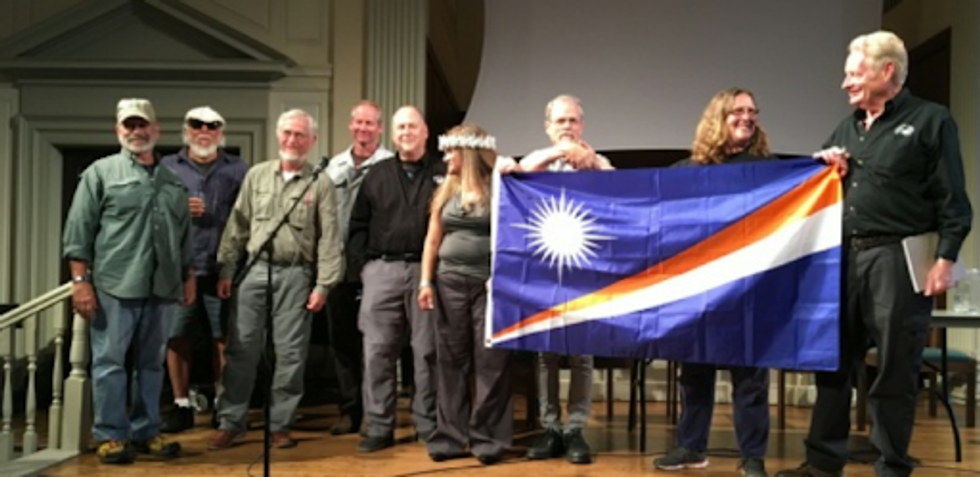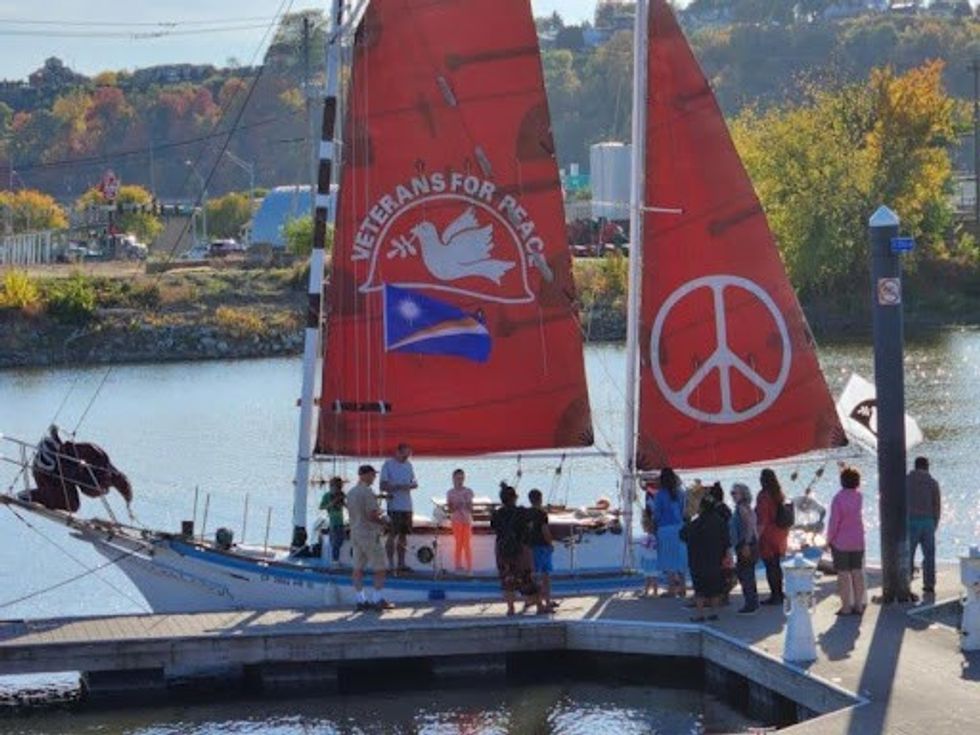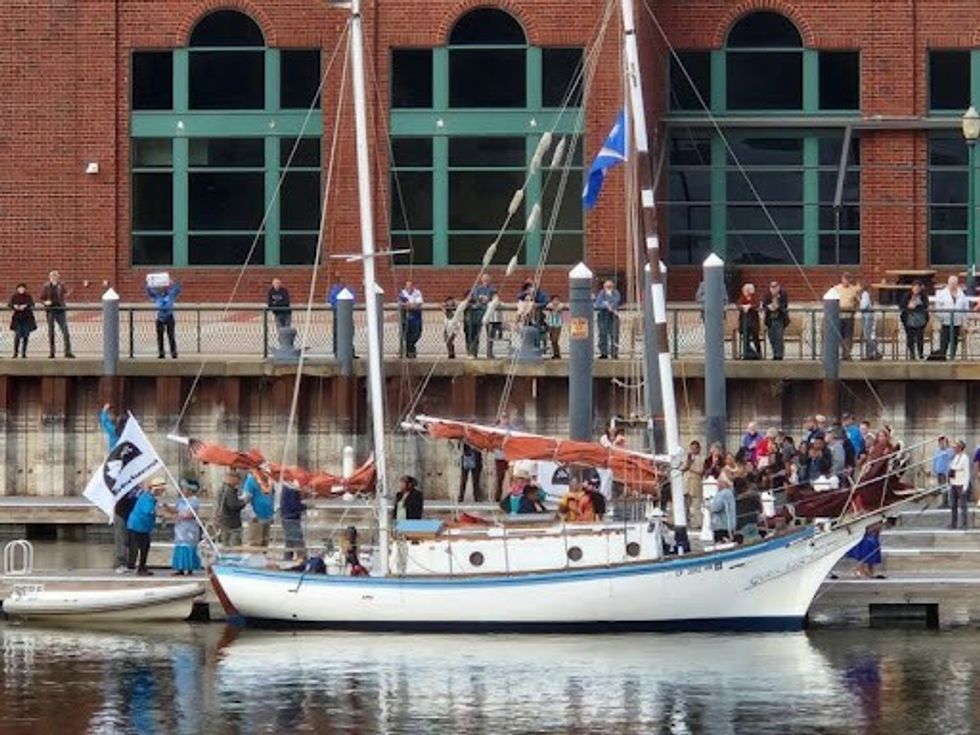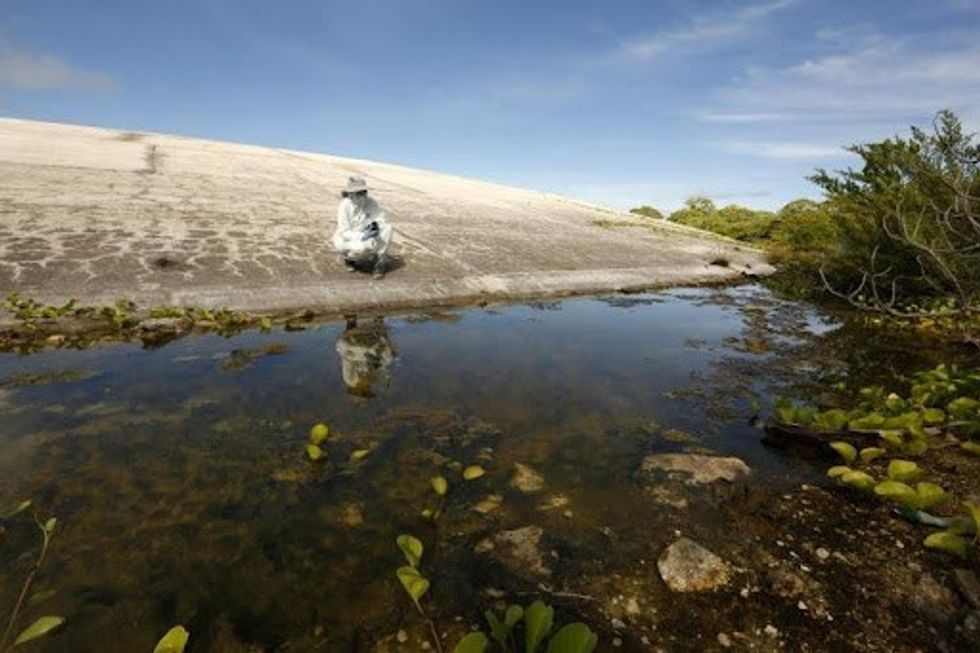

SUBSCRIBE TO OUR FREE NEWSLETTER
Daily news & progressive opinion—funded by the people, not the corporations—delivered straight to your inbox.
5
#000000
#FFFFFF
To donate by check, phone, or other method, see our More Ways to Give page.


Daily news & progressive opinion—funded by the people, not the corporations—delivered straight to your inbox.
Between 1946 and 1958 the U.S. detonated 67 nuclear weapons in the Marshall Islands that vaporized whole islands, carved craters into the shallow lagoons, and exiled hundreds of people from their homes.
March 1 marks 70 years since the U.S. used its biggest ever nuclear weapon—on Bikini Atoll in the Marshall Islands. The bomb was 15 megatons, 1,000 times more powerful than the bomb dropped on Hiroshima.
On this day we remember the victims of the Castle Bravo nuclear blast and all other victims of the nuclear era, which has brought untold pain, death, and damage, affecting both people and planet in profound ways.
There’s no better way to remember Castle Bravo day than by taking action on behalf of the victims of radiation and pushing for the abolition of nuclear weapons.
Between 1946 and 1958 the U.S. detonated 67 nuclear weapons in the Marshall Islands. The blasts vaporized whole islands, carved craters into the shallow lagoons, and exiled hundreds of people from their homes. The Castle Bravo blast was the largest of all, sending particulate and gaseous fallout around the entire planet.
Concerned U.S. citizens tried to stop the tests by contacting Congress, the president, and the press and by demonstrating on campuses and in the streets. They weren’t successful through these conventional means, so in 1958 four Quakers bought a small sailboat, the Golden Rule, and attempted to sail her right into the testing zone in the Marshall Islands.
The crew of the Golden Rule was arrested in Honolulu and could not continue. A second boat, the Phoenix of Hiroshima, took the baton and completed the sail into the Marshall Islands, resulting in the arrest of the Phoenix’s captain. The actions and arrests of these crews spurred a massive public outcry that finally led to the Limited Test Ban Treaty of 1963.
The Golden Rule also inspired the founding of Greenpeace in 1971, whose first mission was to sail to Amchitka Island, Alaska, to stop nuclear weapons testing. The U.S. Navy stopped Greenpeace, too. The nuclear bomb the group had come to stop was detonated, but the subsequent tests were canceled and the U.S. stopped the entire Amchitka nuclear test program.Greenpeace and her vessel, the Rainbow Warrior, played an important role in the Marshall Islands in 1985 when Rongelap residents asked Greenpeace to help them relocate to a new home. Both Bikini and Enewetak’s people were evacuated from their island homes prior to the nuclear tests, hoping to avoid radioactive fallout. But the inhabitants of Rongelap (150 kilometers away) were not so fortunate. Within four hours of the Castle Bravo explosion, fallout was settling on the island. A fine white ash landed on the heads and bare arms of people standing in the open. It dissolved into water supplies and drifted into houses.
With double the usual miscarriages and other health problems caused by the Castle Bravo test, the people of Rongelap begged the U.S. government to evacuate them. But they were now human “guinea pigs,” and U.S. scientists wanted to study the effects of radiation on the population.
Finally, in 1985, Greenpeace made three 180 kilometer trips from Rongelap to Mejato (in the Kwajalein Atoll), taking 300 islanders to safety.
The Golden Rule disappeared from public view in 1958 and eventually sank in Humboldt Bay in far northern California in 2010. After a five-year rebuild, she was re-launched and returned to her anti-nuclear mission by Veterans For Peace.
In 2016 when the Golden Rule visited Portland, Oregon, we visited with a Marshallese group who built a traditional sailing canoe. Most people in and from the Marshall Islands have never heard of the Golden Rule or the Phoenix of Hiroshima. However, when they hear the story, they are very excited that people attempted to help them all those years ago.

Kiana Juda-Angelo presented the Golden Rule Project with a Marshallese flag at our public presentation in Portland, Oregon in 2016.

Hawaii has one of the largest populations of Marshall Islanders in the U.S. It has been our pleasure to meet them and commemorate Nuclear Victims Remembrance Day in Honolulu in 2019.

In 2022, as the Golden Rule sailed down the Mississippi River along the “Great Loop,” we passed through Dubuque, Iowa, where there is a community of 800 or so Marshall Islanders. Veterans For Peace member Art Roche told them the story of the Golden Rule’s 1958 voyage and that we were bringing the boat to Dubuque! They greeted us with leis and songs of sweet harmony in their traditional clothing. We enjoyed dancing, speeches, and song for a whole weekend.

When the Golden Rule was in New York City we met the Permanent United Nations Representative from the Republic of the Marshall Islands, Ambassador Amatlain Elizabeth Kabua. She explained that there were several issues that could be improved:
For the last three decades, Marshall Islanders have sought compensation from the U.S. for the health and environmental effects of nuclear testing. They’ve been denied standing to sue in U.S. courts, and Congress has declined their requests. The Compact of Free Association (COFA) which governs the relationship between the U.S., Palau, Micronesia, and the Republic of the Marshall Islands was renegotiated in 2023. However, Congress has yet to fund the $7 billion dollars that was approved.
The Marshall Islands are also being hit hard by global warming and slowly sinking into the rising seas. This will submerge a highly radioactive nuclear waste dump, Runit dome. Runit dome contains nuclear contamination from both the Marshall Islands and the Nevada test site.

On March 1, let’s remember all of the victims of radiation—from Hiroshima and Nagasaki; nuclear testing areas; and uranium mining, milling, processing, and disposal sites.
Let your senators and representative know that you support fully funding the Compact of Free Association (COFA).
Tell them that you support the Radiation Exposure Compensation Act, including its expansion to include those people exposed from the Trinity test in New Mexico in 1945.
Work for the U.S. to sign the U.N. Treaty on the Prohibition of Nuclear Weapons (TPNW), which includes compensation for victims of radiation. The International Campaign to Abolish Nuclear Weapons, ICAN, which won the Nobel Peace Prize in 2017, is working hard to get all nations to sign the treaty.
Back from the Brink urges the U.S. government to:
Their website has an advocacy toolkit and sample scripts for talking with the press and policy makers.
Two important bills are in Congress: H. Res 77 would implement the Back from the Brink Measures. HR 2775 would move money from nuclear weapons manufacturing to funding fossil-free, nuclear-free energy as well as human needs. Ask your representative to sponsor these bills and your senators to introduce a companion bill!
There’s no better way to remember Castle Bravo day than by taking action on behalf of the victims of radiation and pushing for the abolition of nuclear weapons.
We will be reminding the world of the Hibakusha truth that “human beings and nuclear weapons cannot coexist.”
Later this month I will return to Japan for the annual Bikini commemoration and the Gensuikyō, or Japan Council Against Atomic and Hydrogen Bombs, annual conference. There won’t be a bikini fashion show.
The commemoration of what can only be called the criminal U.S. Bravo H-bomb test on March 1, 1954, is one of two annual anchor events of the Japanese peace movement. Although Covid-19 is still with us, these events will play important roles in revitalizing the Japanese peace movement; one of the most effective in the world.
Over the years, this movement has played a major role in preventing Japan from becoming a nuclear weapons state, and the testimonies of Hibakusha (victims and witnesses of the A-bombings) have played critical roles in inspiring the nuclear disarmament diplomacy and the international negotiations that resulted in the 2017 United Nations Treaty on the Prohibition of Nuclear Weapons.
Although I initially met several Hiroshima and Nagasaki A-bomb survivors as early as the 1978 U.N. Second Session of Nuclear Disarmament, it wasn’t until I first traveled to Hiroshima in 1984 that I began what became a 40-year engagement with Hibakusha and the Japanese movement.
Bikini Day will be little remarked here in the United States: Cowboys and Indians all over again, and quite literally a case of nuclear colonialism.
In an effort to compensate for his earlier support for the Nuclear Weapons Freeze campaign and to bring nonexistent jobs bacon to Boston, Senator Ted Kennedy (D-Mass.) and, following him, the Massachusetts congressional delegation and the city’s business establishment were suckered into Reagan-administration planning to transform Boston Harbor into a nuclear weapons base. Knowing the Navy’s record of nuclear weapons accidents, the ways that the base would ratchet up tensions with Moscow and violate the freeze, and with knowledge of better economic and social uses for the waterfront property, several of us organized at the grassroots level to prevent construction of the base. We prevailed, and I was invited to give a brief inspirational speech at the World Conference against A- and H- Bombs. Needless to say, my first trip to Hiroshima was a transformative experience.
Not long thereafter, I returned to Japan for the Bikini Day commemorations and was shocked by what I learned from the testimonies of Rongelap and Japanese survivors of the March 1, 1954, Bravo “test.” Bravo was by far the most devastating of the United States’ nuclear weapons explosions that pulverized Bikini between 1946 and 1958. It was detonated a year after the Soviets tested their first H-bomb and two years before a culturally explosive women’s two-piece swimsuit was first marketed in Paris.
Washington responded to the Soviet Union’s first H-bomb with a bomb 1,000 times more powerful than the Hiroshima A-bomb that destroyed an entire city, initially killed 100,000 people—almost all civilians—and poisoned survivors, the environment, and future generations. Ninety-eight miles away from the Bikini H-bomb test site, inhabitants of tropical Rongelap Atoll were showered by and played with radioactive ash that they first thought was snow. Just 500 miles from the equator, they had never seen snow. Japanese fishing boats hundreds of miles from Bikini Atoll and fish that comprised a major portion of Japan’s ocean-based food supply were also irradiated.
Before the year was out, natives of Rongelap and Japanese fishermen began to die from radiation diseases and cancer. Still births and numerous birth defects including jellyfish babies (transparent skin and no bones), anencephaly (infants born without portions of their brain or skull), and other mutations followed.
Secrecy was immediately imposed by both the U.S. and Japanese governments. But as word got out following the return of the Lucky Dragon V tuna fishing boat’s sickened crew to Yaizu City, women with memories of Hiroshima launched a petition campaign for the abolition of nuclear weapons. It garnered 25 million Japanese signatures, leading to the convening of the first World Conference against A- and H- Bombs, which attracted delegates from across Japan and around the world.
Hiroshima and Nagasaki A-bomb victims, many of whom had hidden themselves from the world due to their disfigurements, excruciating physical and emotional pains, and popular fears that their radiation diseases were contagious began to tell their stories. What became the world’s most powerful and long enduring nuclear disarmament social movement was born.
Two years after Bravo, in 1956, the first Godzilla film was released. Unlike the deracinated version shown across the United States, it was not the compelling story of a love triangle. It was a powerful expression of rage against the A-and H- bombs, a cry for the elimination of nuclear weapons. Watching it now, the desperate fear of nuclear weapons in the aftermath of the Hiroshima, Nagasaki, and Bikini bombs—fears blunted over the decades—remains palpable.
Race was, of course, a factor. During the Pacific War, The New York Times quoted a U.S. general as saying that he and his troops saw Japanese as “vermin” to be eradicated. The implicit assumption was that Marshallese were darker skinned primitives who could be sacrificed, ostensibly in the pursuit of world peace. In both cases, Japanese Hibakusha and Rongelap claimed that they were used as human “guinea pigs,” monitored by doctors and other scientists but not given medicine.
This outrageous charge was difficult and painful to believe, bringing to mind as it did Dr. Joseph Mengele’s murderous experiments at the Auschwitz death camp. But in 2000, in the course of hosting a “Global Hibakusha delegation” for a conference at the United Nations, several of us met with the senior Department of Energy (DOE) official who was responsible for studies of the impacts of radiation on people. I explained that in Japan I had heard Hibakusha cry out that they had been used as “guinea pigs” in experiments conducted by the Atomic Bomb Causality Commission. I said that I could understand victims thinking the worst of their tormentors, but expressed some doubt and asked if he could say it wasn’t so.
“No,” he responded. The experiments had indeed been conducted. And a Utah downwinder who was with us raged in response that the same was secretly being done across the western United States. She was a woman who had lost her father and father-in-law to uranium mining, her sister and daughter to Nevada test fallout, and who consumed a daily meal of pills simply to stay alive
Some years later I experienced an equally sobering reverberation from the Bikini H-bomb. It came during a lunch break in a well-appointed conference site during another annual Bikini commemoration. A descendant of Rongelap Hibakusha was given a book about the Bikini H-bomb and its devastations. It included a list of the names of each of Rongelap’s inhabitants on that 1954 March 1 morning. One by one this young man placed a check mark next to the name of each person who had died of cancer and other radiation diseases from the Bravo “test.” I watched amidst very painful silence as he methodically checked off the names of nearly every person on the list. Some were women and men I had met along our ways.
This is not simply history. In preparation for the Bikini commemoration, this year I came across two recent articles in the Bulletin of the Atomic Scientists written by Robert Alverez, formerly a senior policy adviser at the DOE. Coincident with the release of Oppenheimer, Alvarez reported that Oppie and Lawrence (for whom the Lawrence Livermore lab is named) performed a “vaudeville” on themselves and others. To keep up their teams’ morale, they drank glasses of water with radioactive sodium and in some cases had lower level workers consume plutonium. More than a few, including Oppenheimer—who was also a smoker—subsequently died of cancer.
In his article “Seeking Justice for Radiation Victims of the U.S. Nuclear Program,” Alverez reviewed the campaigns of downwinders and tribal uranium miners for compensation via the Radiation Exposure Compensation Act (RECA). He reports that, ostensibly to limit federal spending (at the same time that the U.S. has embarked on a nearly $2 trillion nuclear weapons “modernization” campaign) Congress recently refused to extend support for “victims not accounted for in earlier legislation.”
Bikini Day will be little remarked here in the United States: Cowboys and Indians all over again, and quite literally a case of nuclear colonialism. But those who gather in the Marshall Islands and Yaizu City in Japan will not only be marking the 70th anniversary of the devastating Bravo test and honoring those victimized and lost. We will also be reminding the world of the Hibakusha truth that “human beings and nuclear weapons cannot coexist.”
The hands of the Bulletin of the Atomic Scientists’ Doomsday Clock are now set at 90 second to midnight. We face the risks of possible nuclear escalation in Ukraine, the Middle East, and over Taiwan tensions. With the post-Cold War order in free fall, all nine nuclear weapons states are escalating their arms racing, “modernizing” or expanding their nuclear arsenals. In these critical movements the messages from the Marshall Islands, Yaizu City, and nearby Shizuoka will be clear: The U.N. Treaty on Prohibition of Nuclear Weapons must be universally signed and ratified to make way for a nuclear weapons-free world. And here in the United States, campaigns like Back from the Brink provide paths and hope for human survival.
What must be found is the will!